-
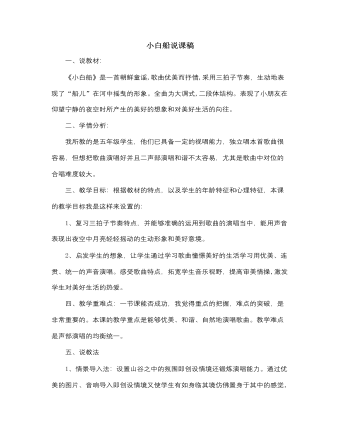
人音版小学音乐五年级下册小白船说课稿
多媒体让学生直观地掌握好音高,巩固歌曲旋律的掌握,积累读谱经验。六、创造表现-----享受过程在学生能熟练演唱的基础上,让学生选择竖笛为歌曲伴奏,还可以让学生边唱边即兴表演。让学生自由组合分成打击乐器组、演唱表演组和竖笛组,调动学生多种感官参与音乐体验和表现,加深了对这一音乐作品的感受,获得审美体验。这里我启发学生用自己喜欢的各种方式来表现歌曲,可以是身体语言、也可以是打击乐器。门德尔松说过一首我喜爱的乐曲,所传给我的思想和意义是不能用语言表达的。通过充分的音乐实践培养学生的能力,提高音乐素养。从目标的提出、到过程的安排、学习方法的确定、乃至学习成果的呈现,都让学生有更大的自主性、更多的实践性、更浓的创造性,让学生的音乐课堂更加丰富,教学成效更加明显。
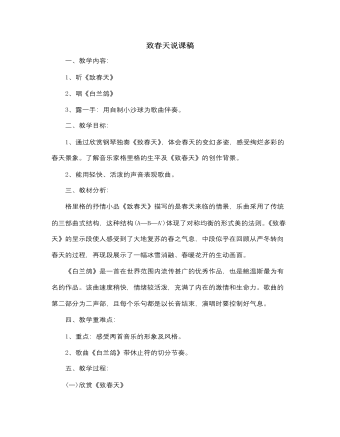
人音版小学音乐五年级下册致春天说课稿
2、学生模仿,解决切分节奏。起 飞 落3、师:在世界音乐的五彩天空里,飞翔着一只美丽的“鸽子”,这就是那首著名的美国歌曲《白兰鸽》。这首歌曲诞生于20世纪,旋律优美动听,多少年来,一直被世界各国的人们喜爱和传唱。欣赏《白兰鸽》4、听了歌曲你感受到了什么?5、再次欣赏歌曲,学生跟师一起用动作表现鸽子的形象。6、学习歌曲①学生跟琴用LU轻声哼唱旋律②出示歌谱,请学生仔细观察哪些地方是相同的?哪些地方是不同的?用色块表现出相同和不同?③跟琴学唱歌曲。④完整熟练地演唱歌曲。7、用自制的乐器为歌曲伴奏请学生自由设计伴奏型,师从旁指导。为歌曲伴奏。(三)拓展欣赏英文版的《白兰鸽》(四)课堂小结以上就是小学五年级音乐致春天说课稿全部内容供家长参考,祝能够进入是适合的学校!
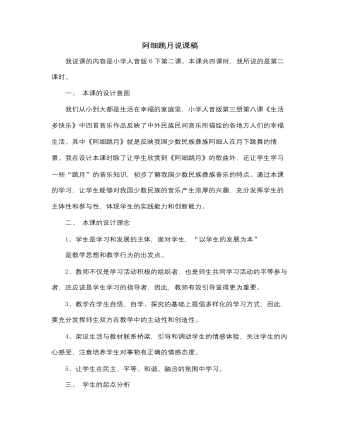
人音版小学音乐六年级下册阿细跳月说课稿
这一环节中,学生初步感受乐曲的主题旋律,学习“跳月”的舞蹈动作,并能够跟着琴来学唱《阿细跳月》的主题旋律。学生在这一环节中非常活跃,与教师的互动也很和谐。把课堂推上了一个小的高潮,不知不觉中解决教学难点。第三环节:听赏乐曲,复习巩固本环节设计三次让学生完整的欣赏乐曲。第一次让学生完整听,感受乐曲旋律的欢快跳跃的感觉,第二次听时让学生思考问题去听,第三次让学生跟着乐曲作“跳月”的动作。三次整的欣赏学生对《阿细跳月》又有了新的了解。第四环节:介绍乐曲,丰富知识学生对《阿细跳月》的了解非常的少,教师简单的介绍它的知识,再一次吸引学生的注意力,让学生对我国少数民族的音乐兴趣更加的浓厚。教师与学生一同跳起欢快的舞蹈,把课堂再次推向高潮。教师在高潮中结束本课。在这堂课中,学生愉快的学习了知识,充分发挥了他们的主体性和参与性,体现了学生的实践能力和创新能力。
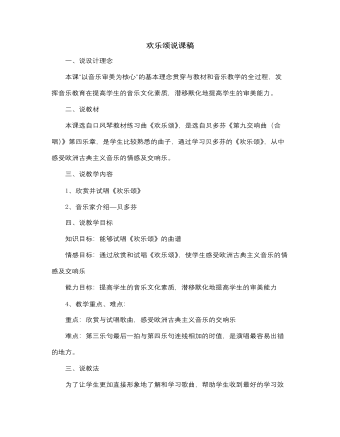
人音版小学音乐六年级下册欢乐颂说课稿
2、视频欣赏进入重点突破难点a、在这个环节我会播放电脑课件,让学生视听欣赏本曲,引导学生在参与欣赏音乐的活动中探索发现,深化情感体验。这是本课的重点。b、视听之后让学生用跟唱法学习歌曲,用“la”模唱,由于这首歌曲调很单纯,4/4拍子,所以学生完全有能力独立学会它。但能够完全无误地演唱好歌曲第三乐句最后一拍与第四乐句连线相加的时值便是本曲要突破解决的难点。在这个地方我会乐曲重复播放,利用电脑直接点击循环再现,为课堂省下不必要浪费的时间。这个环节我会对学生演唱歌曲进行检测,看是否已经解决了难点。方法有:A.全班同学或分组模唱B.个别模唱难点旋律C.难点旋律数、打拍子3、曲谱的试唱试唱曲谱强化学生听觉训练。美国作曲家、音乐教育家艾伦?科普兰说:“如果你要更好地理解音乐,再也没有比倾听音乐更重要的了。”
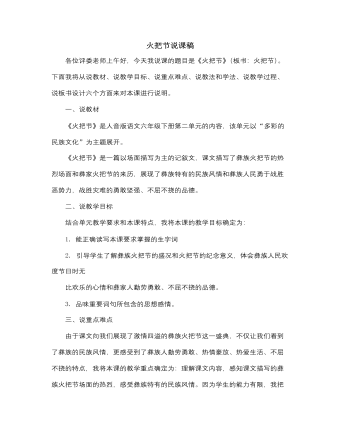
人音版小学音乐六年级下册火把节说课稿
同学们,看了这个传奇故事,那你们知道彝族人身上都体现了一个怎样的精神品质呢?此问题的设计既调动了学生的发散性思维,又可培养学生对彝族人精神品质的敬畏之情。环节5:研读赏析新课标中明确指出:“阅读是学生个性化的行为,不应以教师的分析来代替学生的阅读实践。”教师给学生充足的时间,让学生带着感情读出你喜欢的句子或段落,说出自己喜欢 的理由或者感受。其他学生可以适时做补充,或者引发讨论,让学生在积极主动的思维和讨论中,加深理解和体验,有所感悟和思考,从而受到情感熏陶获得思想启迪,进而解决教学难点。环节6拓展延伸1.写一个场面描写。2.用你喜欢的方式表达你的情感发挥学生想象力,理论-实践,学以致用。六、说板书设计好的板书就像一份微型教案,此板书力图全面而简明的将授课内容传递给学生,清晰直观,便于学生理解和记忆,理清文章脉络。
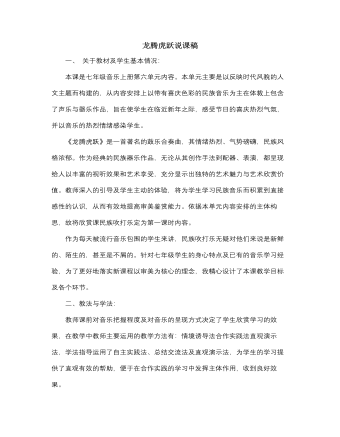
人音版小学音乐六年级下册龙腾虎跃说课稿
聆听感悟—本环节是模式实施的重要环节,也是围绕新课程理念提高审美,落实教学目标的关键。在此,从学生学习的角度出发,又细化为三个步骤具体实施:1、初步感知2、深入体验3、复听感悟。这三个步骤的实施目的在于,使得学生对于音乐的体验和感悟呈现出一个由表及里循序渐进的过程。先是使学生获得初浅的整体印象,再由教师精心选择设计特色音乐片段共同聆听体验,并引导启发学生感悟音乐,使学生逐步积累一些欣赏音乐的知识,有意识地将听觉、音乐理论及自身感悟巧妙融合,形成学习和鉴赏的基本方法,从而提高对于音乐的感悟和鉴赏能力。其中复听感悟环节往往会受到乐曲篇幅及时间所限制,如本课《龙腾虎跃》一曲,如果完整欣赏一次需八分多钟的时间,因此,考虑到学生学习民乐的经验和实际情况,故作调整:将总体感悟乐曲放到第二课时进行。
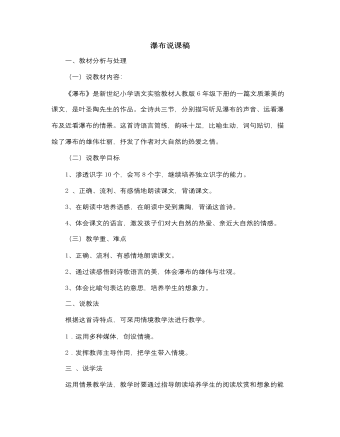
人音版小学音乐六年级下册瀑布说课稿
4、读第3小节。加快脚步,我们现在站到了瀑布的脚下。又看到了什么?自己读,想想瀑布又是怎样的?指名说。(示图)分别指导读好这两个句子。男女合作读这一小节。[这一段的学习,先引导学生想象,发展学生想象力;再适当运用多媒体,提升孩子的感悟,升华情感,引导孩子达到学文、入情的高潮。](四)以读代讲 情感升华瀑布多么美呀!再读,你会更加感受到它的美。下面我们随着动人的音乐,一起美美地读一读这首优美的诗歌吧!配乐齐读。大自然中还有很多象庐山瀑布这样美丽的风景,利用空闲时间,请你走进大自然,去欣赏更多的美景吧!(五)作业1、背诵小诗。(全体都完成)2、如果你愿意,画一画你亲眼见到的或者从电视等其他地方看到的瀑布,为它配上一首自己写的小诗。(自主选择)
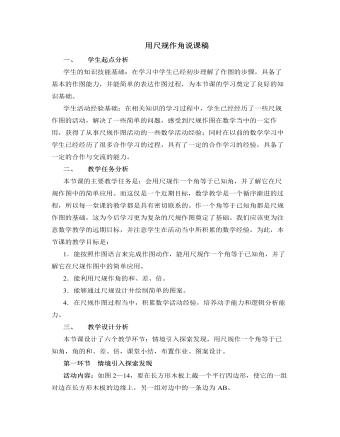
北师大版初中七年级数学下册用尺规作角说课稿
活动目的:通过两个图案设计,一个是让学生独立思考,借助于已经学习的用尺规作线段和角来完成,对本节课的知识进一步巩固应用;另一个是让学生根据作图步骤借助于尺规完成图案,进一步培养学生几何语言表达能力,并积累尺规作图的活动经验。活动注意事项:根据课堂时间安排,可灵活进行处理,既可以作为本节课的实际应用,也可以作为课下的联系拓广,从而使得不同层次的学生都学到有价值的数学。四、 教学设计反思1.利用现实情景引入新课,既能体现数学知识与客观世界的良好结合,又能唤起学生的求知欲望和探求意识。而在了解基础知识以后,将其进行一定的升华,也能使学生明白学以致用的道理、体会知识的渐进发展过程,增强思维能力的培养。同时,在整个探究过程中,怎样团结协作、如何共同寻找解题的突破口,也是学生逐步提高的一个途径。
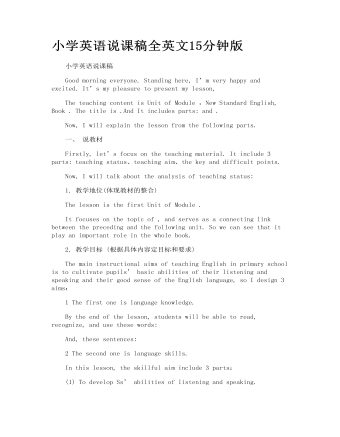
小学英语说课稿全英文15分钟版
一、 说教材 Firstly, let’s focus on theteaching material. It include 3 parts: teaching status、teachingaim、the key and difficult points. Now, I will talk about the analysis of teaching status: 1. 教学地位(体现教材的整合) The lesson is the first Unit of Module . It focuses on the topic of , and serves as a connectinglink between the preceding and the following unit. So we can see that it playan important role in the whole book. 2. 教学目标 (根据具体内容定目标和要求) The main instructional aims of teaching English inprimary school is to cultivate pupils’ basic abilitiesof their listening and speaking and their good sense of the English language,so I design 3 aims:

人教版高中英语必修4Body Language说课稿4篇
Textbook: Senior English for China (Book 4), by Liu Daoyi Time Allotment: 1 period (40 minutes)Date: March 20, 2014Teaching aids: blackboard, Multi-media, Power Point, chalk I. Text Analysis (教材分析)This unit is about body language, and the text selected in the reading part demonstrates the difference and similarity of body language in many parts of the world. Through learning this passage, students are required to raise their awareness of using body language in different parts of the world. As body language is closely related to our daily life, it is easy to arouse students’ interest in learning this text. Reading skills and speaking training are designed around the text.II. Teaching Objectives (教学目标)By the end of the lesson, students will be able to:1. Language Skill Objective(语言技能目标): develop reading ability (skimming and scanning)as well as speaking ability.2. Cultural Knowledge Objective(文化知识目标): know about the cultural differences of using body language.3. Affective Objective(情感目标): increase students’ awareness of using body language correctly in different cultures. III.Teaching Focuses and Difficulties(教学重点和难点)1. Teaching Focuses(教学重点): the difference and similarity of body language in many parts of the world.2. Teaching Difficulties(教学难点): develop students’ reading abilities of skimming and scanning and ask the students to show their opinions with fluent English.

人教版高中英语必修1Anne's best friend说课稿
Step 7 Language points 1.Vocabulary (1) go through (2) set down (3) a series of (4) on purpose (5) in order to (6)at dusk (7)entirely (8)face to face 2.Important sentences (1)…I’ve grown so crazy about everything to do with nature. (2)There was a time when … (3)I stayed awake on purpose until … (4)It was the first time … that I’d seen the night … (5)It’s no pleasure looking through … Purpose: 1.Master the required vocabulary and sentence structures. 2.Use them freely. Step 8 Consolidation 1.Find out the topic sentences 2.Retell the text according to the topic sentences Purpose: I want to know if my students understand the text. Step 9 Discussion Imagine you have to go into hiding like Anne and her family, what would you miss most? Giveyour reasons. Purpose: Train Ss’ oral English ability. Step 10 Homework Write an article on Friends. Purpose: 1. Improve the Ss’ writing ability. 2 Train the Ss’ ability of self—teaching and looking up information by themselves. Part 5 Blackboard design(说板书设计)Unit 1 Friendship Reading Anne’s Best Friend 1.Main idea of each paragraph: Para. 1 Anne made her diary her best friend. Para .2 Anne wrote her feelings in her diary. Para .3 Anne missed nature. Para.4 Anne saw the night face to face Para.5 Anne wanted to experience nature outdoors. 2.Listening: Exx.1 P3 3.Discussion: Exx.3 P3 Purpose: 1.Make Ss familiar with the passage 2.Make the design inductive, instructive and artistic.

人教版高中英语必修1Nelson Mandela--A Modern Hero说课稿
In this step, give students a few minutes to read the passage . While they are reading, I will write some key words of the text on the blackboard. Then ask students to retell the passage according to the key words.By retelling, students can improve their ability of language organization and have an overall understanding of the article.Step 4 Group discussionIn this step, students will be divided into groups of 4 to discussion the following question: What qualities make a great person?After their discussion, invite a few groups to make a report to the class.This group discussion can practice students’ oral English and cultivate their abilities of cooperation and communication.Step 5. HomeworkLet students write a short passage to introduce a great person he or she admires.The homework can consolidate the knowledge the students have learned and cultivate their writing ability. Part 6 Blackboard Design(板书设计)That’s all my teaching procedures. Finally, I’d like to say sth about part 6 blackboard design. On the top is the title. On the left, there will be some new words and expressions. In the middle of the blackboard, I will write some useful sentence structures so that the students can know clearly what they’ve learned and then try to master the knowledge.OK. That’s all for my presentation. Thank you for your attention.

人教版高中英语必修2Computers说课稿3篇
一. 教材分析1. 本单元的中心话题是“计算机(Computers)”,内容涉及计算机的发展历史,计算机的应用等。本节课是该单元的第一课时,我将Warming up, Pre-reading and Comprehending这四部分整合为一节精读课。其中。Reading部分是题为WHO AM I?的文章,以第一人称的拟人手法介绍了计算机发长演变的历史和计算机在各个领域的应用,其主旨是表达计算机的发展变化之快以及在生活中用途之广。而Warming up部分以图片的形式展现了计算机的发展历程;Pre-reading中的问题和排序分别是为了预测语篇的内容和测试学生对计算机历史了解的情况;Comprehending则通过各项练习训练学生的阅读技能,从而加深对文章的理解。可见这几部分是一个有机的整体。2. 教学目标:1) 语言目标:重点词汇及短语:abacus, calculate, calculator, PC, laptop, PDA, robot, analytical, technological, universal, mathematical, artificial, intelligent, network, explore, in common, as a result.重点句子:a. My real father was Alan Turing, who in 1963 wrote a book to describe how computers could be made to work, and build a “universal machine” to solve any mathematical problem.

人教版高中英语必修2Cultural Relics说课稿2篇
Ⅲ. Analysis of the teaching material:The topic of this unit is cultural relics. Students are quite interested in topics about different cultures around the world. This is the second period of the whole unit. As a reading class, the passage mainly talks about the history of the amber room (how it was made, sent as a gift, lost and rebuilt).According to the new national curriculum, when teaching reading, much emphasis should be put on training the students’ reading skills.Ⅳ. Teaching objectives1. Language objectives:1) Students are required to master the key words and phrases occurred in the passage (e.g. amazing, decorate, belong, in return, less than etc.)2) Students are required to learn the attributive clause and acquire the sentence pattern.2. 1) Students are required to describe a certain thing by using the new sentence patterns.2) Students are required to master two kinds of reading skills—skimming and scanning, and learn to use them in their daily reading.3. 1) Students are required to know the history of the amber room.2) Students are required to appreciate cultural relics and understand the importance of protecting them.Ⅴ. Teaching important and difficult points1) the new words, phrases, and sentence pattern in the course of reading.2) Teaching difficult point: Help the students master two kinds of reading skills—skimmingand scanning and learn to apply them in daily use.Ⅵ. Teaching methods:Task-based method & Top-down model Ⅶ. Teaching aids: PPT, pictures, blackboard Ⅷ. Teaching procedure:

人教版高中英语必修3Astronomy the science of the stars说课稿3篇
Step 2 Pre-listeningAfter students finish their discussion, I will show a picture of Newton and ask them: Who is him? What is he famous for? Could you find out some words to describe him? Maybe students will answer that he is genius for his finding of theGravitation, making a great contribution to the progress of human being. At that time I will show another two pictures of Einstein and Hawking, letting students guess who they are and write down their idea about the Gravitation. For I have arranged them to search more information about the gravity before this class, Students have beenfamiliar with the topic and will not be afraid about this abstract conception, which is helpful for their listening.Step 3 While-listeningIn this step, students will be required to listen the material for three times. The first and listening is extensive listening and the second and third listening is intensive listening. In the first time, They are required to listen a material including Part 1 and Part 2 and choose the best summary of the listening text. After they choose the right answer, They also need work in group to explain what is wrong with the others. Then I will make a conclusion that we should pay attention to the first paragraph and last paragraph and some keys to get the main idea. By doing this, their capacity of generalization will have a great improvement.Before the second listening, I will ask students to scan the blank on the power point quickly and ask them to note down some key words .Then ask them to listen to the Part 1again and fill the first column of the chart. Maybe some students just show the ideas of these three scientists an still can’t catch their development of gravity. Therefore, I will ask them to listen to Part 2 again and fill in the rest. After finish the listening, I will give them ten minutes to discuss with their partner. I will also guidethem to improve their answers when they discuss with others.

人教版高中英语必修2Wildlife Protection说课稿3篇
When it comes to the students’ studying methods, I'd like to introduce my Ss first. The Ss have a good command of basic language points. They’re interested in learning English, and they take an active part in English class, so they will have fun in autonomous, cooperative and inquiry learning. I will just serve as a guide, showing them the way to explore how to make more progress in their English learning.Now it’s time for the most important stage of this lesson. My teaching procedures are arranged as follows:Step1.Leading-in (3 minute)Play a video of a wide variety of wildlife to introduce my topic. Step2. Speaking (12 minutes)We will use our textbook Page25. Let the Ss fast read the short paragraph to warm up. Ask them to talk about the report on some endangered wildlife in China with the dialogue patterns on the screen. Lastly, I will invite some groups to demonstrate their dialogues about saving wildlife in China.Step3.English play (3 minutes)Watch another video in praise of their excellent performance just now. It’s about Jack Chen’s(成龙)and Yang Ziqiong’s wildlife protection.Step4. Listening (twice 13 minutes)This time, I’ll ask the Ss to fill in the blanks of the monologue of the 2 movie stars above. Step5.Discussion (3 minutes)Which would you like to choose to wear, clothes made of cotton, artificial leather or animal skins? Why ?Step6. Summary (3 minutes)1. If there were no wildlife, there wouldn’t exist human beings. If the buying stops, the killing can, too.2. Animals are our friends. To love animals is to love ourselves. Stop hunting, killing and destroying wildlife.3. Let’s live in harmony with all the living things in the world. Step7. Music appreciation (3 minutes)Let the Ss appreciate the song Earth Song by Michael Jackson. Last but not the least, I will show you my blackboard design.

人教版高中英语必修3Canada-the true north说课稿4篇
Good afternoon, teachers, It’s my great pleasure to be here sharing my lesson with you.The content of my lesson is Senior English Book 3 Unit 5 Canada —— “The true North”.I’ll be ready to begin this lesson from five parts. Analysis of the teaching material,the teaching methods,the studying methods, the teaching procedure,and Blackboard design.First, let me talk about the teaching material.Part 1 Teaching Material:This unit is about the introduction of Canada. By studying of this unit,we’ll enable the students to learn the geography, population, main cities, and natural beauty, natural resources of Canada. Through the training of the unit, it also requires students to learn some Language skills such as the expressions of position and emotions.So it plays an important part in the English teaching in this book.After studying the teaching material and analyzing the rule of children’s growing of mind,I think the teaching aims are the followings:1.Knowledge objects:(1) make the students learn some new words and phrases(2) make the students understand the content of the lesson.2.Ability objects:(1)To develop the Ss’ abilities of listening, speaking, reading and writing. Especially reading and speaking ability.(2) learn to talk about the characters of Canada in English(3)To train the Ss’ ability of working in pairs.3.Emotion objects:(1)Enable students to understand the characters of Canada..(2)Stimulate Ss to work hard to make China stronger.Part 2 Teaching Methods:I think helping students learn to master new words and phrases and improve the students’ reading and speaking ability is import and the difficult.According to the analysis of the teaching material and the import points and the difficult points,I will use the following teaching methods : question-guiding approach; fast-reading and careful reading; multi-media teaching methods; discussion

人教版高中英语必修3Festivals around the World说课稿3篇
Teaching plan for Unit 1 book3Good morning, teachers. It’s my great pleasure to be here because I can share my lesson with you and I can learn a lot from it. I’ll begin my lesson from the following four parts, the teaching material, the teaching methods, the studying methods and the teaching procedure.Firstly, let me talk about the teaching material. The content of my lesson is the reading passage festivals and celebrations of Unit 1 Festivals around the world. This passage is about festivals and celebrations. By studying this passage, we’ll enable the students to know that festivals exit everywhere, and many of festivals in different countries celebrate similar ideas. As we all know, the reading passage is the center of each unit. If the Ss can learn it well, it will be helpful to make the Ss learn the rest of this unit.After studying the teaching material, I think the teaching aims are as the followings:1. Knowledge aims:(1) The Ss can master the usage of the important words andexpressions.(2)The Ss can use the __________________ (grammar) in the proper situation.Make students know about the festivals all over the world and the detail of the festivals, such as origin, content, and the date of the holiday festivals.2. Ability aims:(1) Students can talk about festivals and celebrations in English(2) To improve the student’s reading ability, especially their skimming and scanning ability.3. Emotion aims:Make the Ss know about the foreign festivals, and respect other countries’ custom.Next, let’s come to the important points and the difficult points.The important point is how to make the Ss understand the text better and the difficult point is how can they talk about it. secondly, Teaching Methods:1. task-based Language Teaching2. Computer assisted language teaching.3. question-and–answer methodThirdly, Studying Methods:

人教版高中英语必修4Theme parks说课稿3篇
The oldest and the most popular park in the worldenjoy the exciting activities thereget close to the life-size cartoon characters like Mickey Mouse and Donald Duck Step 3 Pre-reading1.What do you suppose a theme park is ?2.What do you think you can see in a theme park?(1.It is a kind of amusement park which has a certain theme – that the whole park is based on. 2.buildings, castles, statues, rare animals and birds, and so on.) Step 4 Reading ----- Theme Parks –---- Fun and More Than Fun1.Predict : Read the title and the pictures on P. 34 and PredictWhat is the meaning of the title “Theme Park – Fun and more than fun”?(The title means that theme parks are fun to visit, but that they can also be educational and can offer useful information.)2.Skimming Fast read and answer:What activities can we take in a theme park?Amusement park: Bumper car Merry-go-round slide bungee jumping Free-fall rides Horror films Pirate ship Ferris wheel roller coaster3.Scanning Read again and you will find various theme parks are mentioned in the passage . Then what are they ?Theme parks: Sports theme park History theme park Culture theme park Marine or Ocean theme Park Future park Science theme park Disneyland4.Careful reading and find the main idea of each paragraph:THEME PARKS---- entertaining/ educationalPara.1 Traditional parks are places to go for relaxation and to have time away from our busy lives.Para.2 Theme parks are different They’re large and full of things to do, see and buy.Para.3 Theme parks are built around a single idea or theme. One example is a sports park.Para.4 Another kind of theme park is historical more and cultural and can be educational.Para.5 Disneylandwas the first theme park. It is based on the fantasy life and characters of Disney’s films.Para.6 Some examples of educational theme parks include sea world parks and science parks.

人教版高中英语必修4Working The Land说课稿3篇
Knowledge objectives:(1) to make Ss grasp the usage of words, expressions and sentence structures: statistics, struggle, thanks to, rid of, some patterns for persuasion, the “ing” form as subject and object;(2)to use learnt knowledge to persuade sb.Ability objectives:(1) to develop Ss’ reading skills(skimming, scanning, word guessing);(2) to improve Ss’ speaking, communicating and cooperating skills.Emotional objectives:to make Ss know the contribution of Yuan,and learn his spirit and his simple life time.Teaching important and difficult points:(1) some words, expressions and sentence structures mentioned above;(2)the content of the text;(3)training their reading and speaking skills.Teaching methods: CLT, TBLT,QT.Learning strategies: CLS, QLS, TBLS.Teaching procedures:Step 1 lead-in: (1) teacher plays a piece of recent news from CCTV about the harvest of the super hybrid rice, and ask students whether they know Yuan or not, and talk about him and his contribution.(2)Brain storm: let Ss describe Yuan in their minds including his appearance, his living condition and so on.Step 2 fast reading tasks:(1)teacher introduces Yuan and super hybrid rice(2)make Ss read the text as fast as possible with questions. Such as: what’s the general ideaof this passage? What’s Yuan’ dream? (skimming and scanning skill)Step 3 intensive reading tasks(1)let Ss read the text silently, find topic sentence of each paragraph and draw the difficult sentences and the knowledge what they don’t understand.(words guessing)(2)teacher and Ss talk about the important words, expressions and sentences together, and ask Ss to retell the content of the text.(summarizing and paraphrasing)(3)teacher summarize this part.(4) read again following the courseware.